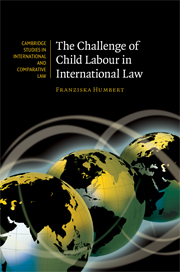Book contents
- Frontmatter
- Contents
- List of abbreviations
- Foreword
- Acknowledgements
- Introduction
- 1 The problem of child labour
- 2 The prohibition of child labour in international law
- 3 UN and ILO implementation mechanisms for the prohibition of child labour
- 4 Trade measures on child labour
- 5 Recommendations for an ILO–WTO enforcement regime
- Concluding summary
- Bibliography
- Index
- CAMBRIDGE STUDIES IN INTERNATIONAL AND COMPARATIVE LAW
3 - UN and ILO implementation mechanisms for the prohibition of child labour
Published online by Cambridge University Press: 20 February 2010
- Frontmatter
- Contents
- List of abbreviations
- Foreword
- Acknowledgements
- Introduction
- 1 The problem of child labour
- 2 The prohibition of child labour in international law
- 3 UN and ILO implementation mechanisms for the prohibition of child labour
- 4 Trade measures on child labour
- 5 Recommendations for an ILO–WTO enforcement regime
- Concluding summary
- Bibliography
- Index
- CAMBRIDGE STUDIES IN INTERNATIONAL AND COMPARATIVE LAW
Summary
INTRODUCTION
Having examined the scope and content of international norms prohibiting child labour, the next question is how these norms are enforced. The following chapter will analyse the UN and ILO implementation systems with a view to asking whether they are still adequate for the elimination of child labour in their current form, or whether reforms are needed.
From a long-term perspective, the key question when assessing implementation systems would be what changes in law and practice occurred in a country after the respective implementation procedure took place. Accordingly, one would have to examine and compare national child labour legislation and the actual situation in the respective countries, and what changes have occurred over a certain period of time. This would require a sustained analysis of government responses to the recommendations of the implementation bodies. Some legal writers have traced the adoption of domestic legal reforms directly to the effort of UN human rights treaty bodies, but, as others have pointed out, identifying the origin of change in law and practice is complex, particularly where such change is gradual or long-term. This is not just because many factors influence changes in law and practice, but also because governments do not always identify what role international scrutiny may have played in motivating changes. In development science, this is referred to as the problem of impact assessment and attribution.
- Type
- Chapter
- Information
- The Challenge of Child Labour in International Law , pp. 122 - 194Publisher: Cambridge University PressPrint publication year: 2009



